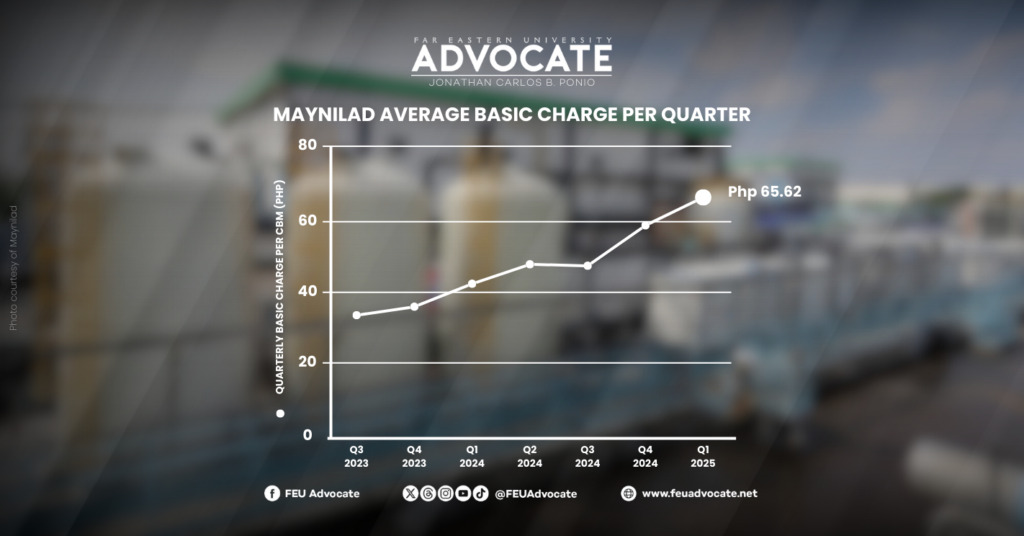
Lady Cagers bow to Lady Bulldogs in UAAP season opener
- September 04, 2019 18:42
FEU Advocate
March 18, 2025 08:00

Far Eastern University (FEU) students residing in dormitories fear financial strain due to higher living expenses caused by the upward hike of utility rates imposed by Meralco and Maynilad Water Services, Inc. at the start of 2025.
Earlier this year, Meralco and Maynilad announced rate increases for their services. For the overall consumption rate for residential consumers, Meralco’s electricity rate rose from the previous P11.7428 per kilowatt-hour (kWh) to P12.0262 per kWh.

This rate increase is the highest for Meralco since November 2023, when the overall rate per kWh reached P12.0545.

Maynilad’s all-in average rose to P65.62 per cubic meter from P58.30 per cubic meter by late 2024, the highest in terms of average rate cost per cubic meter so far.
The drastic hike in electricity and water bills at the start of the year has prompted concerns from affected residents, who now face elevated living costs.
With the higher rates imposed by Meralco and Maynilad, the added financial strain worries students who stay at dormitories near the University.
In separate interviews with FEU Advocate, first-year Communication student-dormers Valerie Tolete and Joshua Dominic Arroyo expressed their dismay over the rate increases in utility bills.
“Hindi naman yata tama na ganun na lang magtataas lalo na’t paparating ang panahon ng tag-init. Lalo na sa aming mga estudyante na wala pa namang source of income at naka-asa lang sa allowance na binibigay ng parents namin,” Tolete exclaimed.
Meanwhile, Arroyo, who stays in a dormitory with his sister along España Boulevard, stated that the increase in both electricity and water bills should have a valid justification for the rate adjustment.
Considering all grounds leading to the utility bills price hike, it will still cause financial distress, especially for working students making ends meet, Arroyo added.
“[That’s] an additional problem to worry about. The issue will further put financial weight on students already struggling to make ends meet, which, of course, is not beneficial, unless justified,” Arroyo remarked.
Last December 2024, the Metropolitan Waterworks and Sewerage System-Regulatory Office (MWSS-RO) announced its approval of the increases in water service rates for both Maynilad and Manila Water Company, Inc.
According to an interview with GMA Integrated News, MWSS-RO Chief Regulator Patrick Ty stated that the regulatory board considered the capital expenditures of Maynilad and Manila Water for the 2023 to 2024 period when approving the rate hike, which took effect in January 2025.
In an announcement last February 11, Meralco attributed its rate hike primarily due to higher generation charges, which cover the cost of purchasing power from suppliers.
In an advisory by Meralco, generation charges increased by P0.385 per kWh in February due to higher costs from independent power producers (IPPs) and power supply agreements (PSAs), which account for 29 percent and 43 percent of the energy supply, respectively.
Aside from the increase in generation charges, the electricity rate adjustment is in accordance with the rise in tax charges, which rose by P0.077 per kWh and other contributing charges by P0.0519 per kWh.
The Energy Regulatory Commission questioned Meralco’s rate increase amid continuous criticisms from consumer advocacy groups, which suggests that consumers' perspectives were not fully considered in the process.
For students already struggling with high living costs, a significant rise in utility bills remains an issue that demands further attention from regulators and policymakers.
Both Tolete and Arroyo, who rely on the allowances provided by their parents, were unaware of the price hike in electricity and water bills, but remain firm that regardless of the reason, both utility companies should at least distribute the increase over the remaining months of 2025 rather than imposing it all at once.
Moreover, a decline in power demand was observed with a significant drop of 585 megawatts (MW) and peak demand reduction of 802 MW in the Luzon grid.
This indicates that if power demand remains low or continues to decline, an offset in regards to the rate hike will be made.
Meanwhile, the MWSS-RO chief regulator said that as long as a reasonable percentage of capital expenditures is spent, Maynilad and other water providers under MWSS-RO will be allowed to increase water supply charges.
Despite the justifications made by Meralco and Maynilad, concerns continue to mount as consumers express their frustrations over the rate hikes, especially with dormers who solely rely on the allowances from their families and benefactors.
With the summer season officially starting in the country, both companies have urged the public to limit power and water usage.
Electricity and water charges usually spike up from March to June due to increased consumer demand to cope with the summer heat.
- Art Santiago
(Photos courtesy of Saksi Ngayon and Maynilad; Layout by Runoel Julius B. Barde/FEU Advocate)









